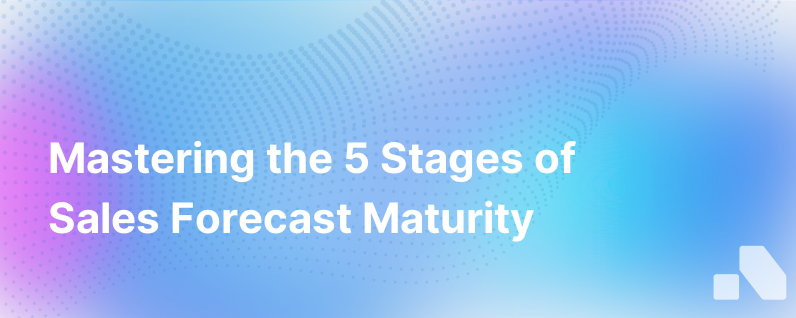5 Stages Of Sales Forecast Maturity
Published on August 14, 2023 by David Zhang
Sales forecasting is an art and a science, an essential practice for businesses that aspire to achieve efficiency, predictability, and sustainability. No matter the size or industry, whether a B2B or a B2C company, forecasts inform a range of critical business decisions – from setting budgets to resource allocation, from assessing future cash flow to shaping strategic plans. Understanding the maturity of your sales forecasting process is essential to recognizing where improvements can be made, thus ensuring your business can scale successfully and meet its targets.
In the path to forecasting maturity, we can often identify five distinct stages. Each stage represents a level of sophistication and reliability in predicting future sales. Let's explore these stages to understand where your organization might fall and how you can progress to the next level.
Stage 1: Basic Excel Modeling
The initial stage of sales forecasting maturity typically involves rudimentary techniques that rely heavily on intuition and past experiences. At this level, sales leaders use basic Excel spreadsheets to manage and predict sales. Forecasting often consists of simply looking at the numbers from the previous period and taking a best guess at what might happen in the next.
Characteristics:
- Reliance on gut feelings supplemented by basic historical data.
- Forecasts are frequently inaccurate and not data-driven.
- High volatility in results, with potential for significant over- or underestimations.
Stage 2: Historical Trend Analysis
As organizations recognize the limitations of pure conjecture, they start to incorporate more sophisticated models. The focus shifts to a quantitative approach, utilizing historical sales data to identify trends and apply them to future periods. Simple statistical methods, like moving averages and linear regression, become part of the forecasting toolkit.
Characteristics:
- Use of historical sales data for trend-based forecasting.
- Introduction of simple analytical and statistical tools.
- Improved accuracy over gut-feel estimates, but can still be reactive rather than proactive.
Stage 3: Structured Processes
Upon climbing to the third stage, companies adopt a more structured sales forecasting process that combines both quantitative and qualitative insights. At this level, sales operations become involved, instituting more formal procedures for collecting data and building forecasts. There may be the implementation of basic CRM tools to manage and track sales pipeline data.
Characteristics:
- Formalized forecasting processes with regular reviews and updates.
- A blend of quantitative trends and qualitative inputs from sales, marketing, and customer success teams.
- Initial stages of CRM adoption for pipeline visibility and management.
Stage 4: Advanced Analytical Methods
In the fourth stage, businesses embrace advanced analytical tools and technologies. They start leveraging statistical modeling, machine learning, and AI-driven insights to refine forecasts. This stage often involves the use of dedicated forecasting software or advanced CRM tools that can model complex patterns and factor in external variables.
Characteristics:
- Use of predictive analytics and machine learning for more sophisticated forecasting.
- Incorporation of external variables like economic indicators and market trends.
- Higher accuracy and reliability in forecasts with data-driven decision making.
Stage 5: Integrated Forecasting Ecosystem
The final stage represents the apex of forecasting maturity. Sales forecasting is fully integrated into the company's business intelligence systems, providing a holistic view of the business. Advanced forecasting tools are tightly coupled with strategic planning and performance monitoring systems, ensuring that forecasts continually adapt to real-time market changes and business operations.
Characteristics:
- Seamless integration of forecasting with other business planning functions.
- Real-time data feeds and updates for always current forecasting.
- Predictive models that are continuously refined through machine learning and human insights.
Progressing Through the Stages
Progressing through the levels of sales forecast maturity requires a strategic plan that addresses people, processes, data, and technology aspects. As the forecast's accuracy and reliability become more sophisticated, your organization will demand increasing involvement from cross-functional teams, better data quality and governance, and advanced analytics capabilities.
To advance from one stage to the next, consider the following general steps:
1. Evaluate your current processes and tools. Identify the gaps in your existing forecasting methodologies, recognizing limitations and potential areas for improvement.
2. Develop a forecast maturity road map. This will detail steps to take, people to involve, processes to refine, and technologies to consider.
3. Embrace cross-functional collaboration. Bring together insights and expertise from sales, marketing, finance, and product development for comprehensive forecasting.
4. Invest in technology. Upgrade your CRM systems, adopt forecasting software, and incorporate advanced analytics capabilities as the complexity of your forecasting needs grows.
5. Prioritize data quality. Ensure your forecast hinges on high-quality data by implementing procedures for data collection, validation, and governance.
6. Integrate forecasting into broader business planning. Align your sales forecasts with strategic objectives, budgeting exercises, and performance metrics to establish a truly integrated approach.
7. Constantly revisit and refine. Keep your forecasting processes dynamic, revisiting assumptions and methods to adapt to changing market conditions and learn from past forecasting performance.
Businesses that intentionally mature their sales forecasting capabilities not only gain a clearer view of the future but are also better equipped to navigate it successfully. With each advancement in maturity, the forecast's influence becomes more strategic, directly contributing to more effective decision-making and long-term business success. Using platforms like Aomni can be a part of this advancement, aiding in the transition from basic methods to an integrated forecasting ecosystem by harnessing the power of AI to synthesize complex data for more accurate predictions.